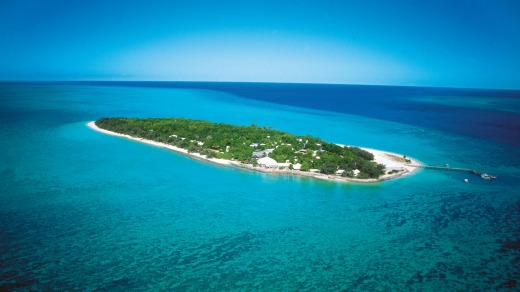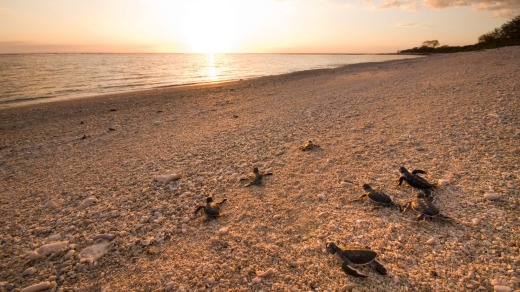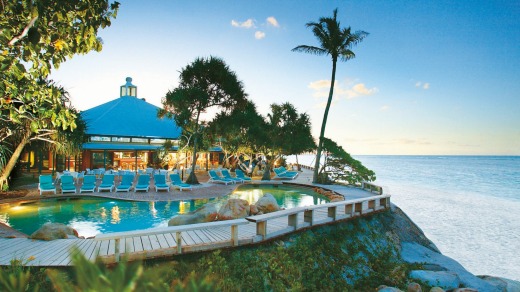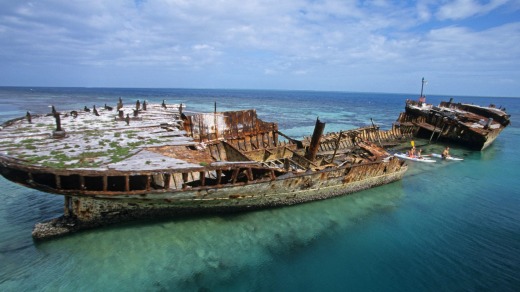One turtle's journey to freedom - from sand nest, across rugged terrain, running the gauntlet of seagulls then sharks in the shallows, to the sea. Heron Island is at the southern end of Australia's Great Barrier Reef.
It's almost sunrise on a small coral cay at the southern end of the Great Barrier Reef when my friend Matt and I notice a small dark thing wriggling on the beach.
We'd got up early in the hope of seeing a nesting turtle or two at the end of their long night shift of egg-laying.
It's the right time of year to see turtle hatchlings too (nesting turtles and hatchlings overlap between January and March), but the wrong time of day: they usually emerge after sunset, when the cooling sand signals the coming darkness, the safest time for them to scuttle to the water's edge.

Yet here it is, a lone hatchling running for its life while silver gulls patrol the skies with breakfast on their minds.
If there's one turtle, there must be others, we figure. We hurry up to the soft sand to search the beach above the high tide mark. That's when we see the mother lode: a veritable turtle volcano erupting right before our eyes. There are at least 50 tiny turtles, clambering over each other and out of the sand nest before sprinting, flippers flapping, towards the shining sun that has just peeked over the horizon.
That's when we see the mother lode: a veritable turtle volcano erupting right before our eyes.
We can hardly believe our luck: a turtle stampede, in perfect light (most hatchling encounters happen in near-darkness) and we're the only ones to see it. There are no other tourists up this early. There aren't even any guides or park rangers around; instead, Heron Island Resort provides turtle-viewing guidelines and other information to minimise our impact on the island's animals and birds – and maximise their impact on us.

I've never seen turtle hatchlings en masse like this, and it's my third trip to Heron. That's the beauty of a place where nature has priority and man-made distractions are kept to a minimum (there's no Wi-Fi, mobile coverage, television or newspapers): there are natural surprises and "wow" moments around every corner. Here are four more from my latest visit.
Clear kayaking
On our first morning, we circumnavigate the island in one of Heron Island Resort's new clear, canoe-shaped "kayaks". Unlike plastic sit-on-tops with Perspex viewing panels, these are clear all over, so you feel as if you're sitting in, not on, the water. It's like snorkelling without getting wet, gliding over eagle rays and blacktip reef sharks, corals and tropical fish, with the added advantage that you can take in the views above sea level too.

We go ashore to investigate fresh turtle tracks on the far side of the island (alas, the turtle that made them is long gone), and around the wreck of the HMCS Protector, a naval gunboat built in 1884 that was scuttled as a breakwater here in 1945, for some offshore birdwatching: its rusting hulk is a favourite perch for brown boobies, black-naped terns and other seabirds.
Close encounters of the bird kind
This 800-metre coral cay teems with seabirds, most prominently up to 120,000 black noddy terns that nest on every branch of every pisonia tree, making for plenty of unexpected bird-human interactions. Prepare to be pooped on, for a start, but don't worry, noddies are small birds and it washes off.

A noddy flies into our room one afternoon, regurgitating a small pile of silvery baitfish onto the tiled floor before we can usher it outside again. Later, a brazen buff-banded rail steals a chip from my hand while I'm sitting by the pool – which explains why you have to dine behind aviary-like netting at the island's open-air restaurant; there are also small trapdoors at ankle height, so waiters can shoo out flightless rails that wander in through the front door.
Night wonders
It's easy to switch back into resort-mode after dark, but nature doesn't clock off. After dinner one night, we walk to the end of the jetty and lie on our backs, listening to the water surge beneath us and looking up at a velvet-black sky full of stars. Then we amble along the beach where more stars glimmer at our feet, twinkles of blue phosphorescence in the shore break, and whenever we shine our torch into the swimming pool-clear water we see dozens of turtles patrolling the shallows.
On our way back to the resort, we almost trip over a muttonbird (wedge-tailed shearwater) sitting on the boardwalk in the dark; until that moment we'd only heard their "oohs" and "aahs", Monty-Pythonesque love songs between mates outside their burrows. So we detour to the bar and order Nutty Chocolate Mutton Bird nightcap-cocktails, in their honour.
Heron Island's Big Five
Who knew Heron Island had a Big Five? We manage to see one of these rare creatures on a two-hour reef walk led by Sara, one of the resort's marine biologists: a small, leopard-spotted epaulette shark that can slow its heart rate and survive for up to six hours out of the water during ultra-low tides on the reef.
We also see 14 kinds of sea cucumber, including the "burnt sausage" (which has a pink, raw-sausage underbelly) and the "long black", which Sara introduces by saying, "I'm going to show you a sea cucumber that will eject its guts out of its bum all over my hand".
As she reaches into the shallows and pulls a black, snake-like sea cucumber from under a rock ledge, white strings shoot from one end of it, a defense mechanism to entangle predators like some aquatic Spiderman. It's just one more of nature's surprises on this surprising island.
Explore Heron Island in 360 degrees via Street View below
heronisland.com
queensland.com
Qantas and Virgin Australia fly from Sydney and Melbourne to Gladstone via Brisbane. From Gladstone, there are two ways to reach Heron Island: by sea (two hours, $60 each way, $30 for children) and by seaplane (25 minutes, $338 one way per person, minimum four people).
Heron Island Resort, the only tourist accommodation on the island, has rooms and suites from $160 a night twin-share, including breakfast, during turtle season, October to March; there are also packages including all meals. See wheronisland.com or call 1300 731 834.